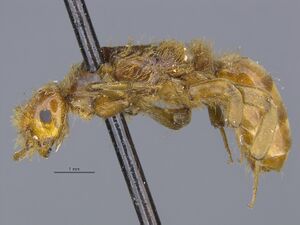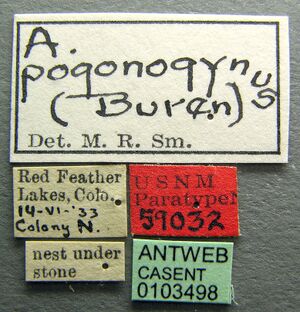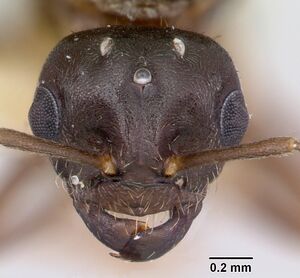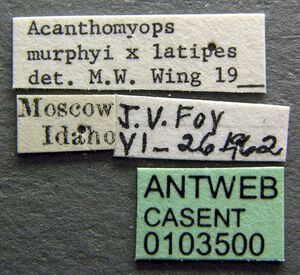Lasius pogonogynus
| Lasius pogonogynus | |
|---|---|

| |
| Scientific classification | |
| Kingdom: | Animalia |
| Phylum: | Arthropoda |
| Class: | Insecta |
| Order: | Hymenoptera |
| Family: | Formicidae |
| Subfamily: | Formicinae |
| Tribe: | Lasiini |
| Genus: | Lasius |
| Section: | flavus clade |
| Species group: | claviger |
| Species: | L. pogonogynus |
| Binomial name | |
| Lasius pogonogynus Buren, 1950 | |
This ant nests under stones. Dealate females were collected loose on the ground during June and July, and early August. Flights occurred from June to July. In New Mexico, nests have been found in a range of habitats, from residential areas to meadows and deciduous forests. (Mackay and Mackay 2002)
| At a Glance | • Temporary parasite |
Identification
Mackay and Mackay (2002) - The hairs on the ventral surface of the head of workers are relatively short (0.20 mm or less) and distributed over the entire surface. The hairs on the gaster are also short (0.22 mm or less) and are also scattered over the entire dorsal surface. The apex of the petiole is blunt (when viewed in profile) and convex or straight as seen from the front (rarely slightly concave).
Wing (1968) - Queen. Similar to latipes, but differing as follows: Standing body hairs unevenly distributed, bent, tangled, and twisted, but not matted to surface. Crest of petiolar scale more pilose. Gula with most hairs appressed. Antennal scapes and funiculi less clavate. Genal plates of fore femora less pronounced. Fore femora with hairs suberect to erect and mostly flexed, those on other femora fewer in number, mostly appressed to decumbent, and straight. SI over 70. FI 51 or less.
Worker. Bears a close resemblance to latipes, from which it is not now separable.
Male. A typical murphyi male associated with the Idaho collection indicates that this hybrid was produced by the cross, murphyi female X latipes male.
Identification Notes
Buren (1950) - This species in many of its characters is intermediate between Lasius latipes and Lasius murphyi, yet in the female, at least, it is perfectly distinct from either. The murphyi female has very dense beard-tufts composed of short, twisted, opaque, appressed hairs; its attenae are rather slender, the legs little flattened, the head wider in front than behind, etc. The latipes female has numerous, evenly scattered, erect hairs; the antennae are very short, and both scapes and funiculi very strongly clavate, the legs extremely flattened, etc.
The workers are much more difficult to separate. Of the three species, pogonogynus appears to have the most numerous hairs. L. murphyi has very short erect hairs and these are numerous on the sclerites occupied by the beard tufts in the female but more or less lacking on other regions, except that the gaster has them present on the entire dorsal surface. The workers of latipes have the erect hairs rather long and flexuous. The petiole of latipes usually has a notch in the superior border which does not occur in the other two species. The head of latipes appears to be widest at or slightly behind the eyes, whereas murphyi has the widest portion somewhat in front. L. pogonogynus is intermediate in having a rather straight-sided head. This species is also intermediate in body size and in antennal length and shape.
Keys including this Species
Distribution
Idaho, Iowa, Colorado, Arizona and New Mexico.
Latitudinal Distribution Pattern
Latitudinal Range: 40.015° to 34.156971°.
| North Temperate |
North Subtropical |
Tropical | South Subtropical |
South Temperate |
- Source: AntMaps
Distribution based on Regional Taxon Lists
Nearctic Region: United States (type locality).
Distribution based on AntMaps
Distribution based on AntWeb specimens
Check data from AntWeb
Countries Occupied
| Number of countries occupied by this species based on AntWiki Regional Taxon Lists. In general, fewer countries occupied indicates a narrower range, while more countries indicates a more widespread species. |

|
Estimated Abundance
| Relative abundance based on number of AntMaps records per species (this species within the purple bar). Fewer records (to the left) indicates a less abundant/encountered species while more records (to the right) indicates more abundant/encountered species. |

|
Biology
This species is likely to be a temporary parasite, but its host is unknown.
Castes
Queen
   
| |
| . | Owned by Museum of Comparative Zoology. |
Images from AntWeb
   
| |
| Queen (alate/dealate). Specimen code casent0103501. Photographer April Nobile, uploaded by California Academy of Sciences. | Owned by USNM, Washington, DC, USA. |
    
| |
| Queen (alate/dealate). Specimen code casent0103496. Photographer April Nobile, uploaded by California Academy of Sciences. | Owned by USNM, Washington, DC, USA. |
   
| |
| Paratype of Lasius pogonogynus. Queen (alate/dealate). Specimen code casent0103498. Photographer April Nobile, uploaded by California Academy of Sciences. | Owned by USNM, Washington, DC, USA. |
Male
Images from AntWeb
    
| |
| Queen (alate/dealate). Specimen code casent0103500. Photographer April Nobile, uploaded by California Academy of Sciences. | Owned by USNM, Washington, DC, USA. |
Nomenclature
The following information is derived from Barry Bolton's Online Catalogue of the Ants of the World.
- pogonogynus. Lasius (Acanthomyops) pogonogynus Buren, 1950: 186 (w.q.) U.S.A.
- Combination in Acanthomyops: Wing, 1968: 117.
- Combination in Lasius: Ward, 2005: 13.
- Status as species: Smith, M.R. 1951a: 854; Smith, D.R. 1979: 1442; Bolton, 1995b: 53; Mackay & Mackay, 2002: 277.
Taxonomic Notes
Wing (1968: 117) suggested that pogonogynus is a murphyi × latipes hybrid, although he did not formally synonymised the name. However, as pointed out by Buren (1950) and Mackay & Mackay (2002), although the workers cannot be distinguished, the queens of these species differ significantly and are easily separated based on morphology alone. It is difficult to believe that species with completely different queens could interbreed and all should be treated as separate species until evidence suggests otherwise.
Type Material
- Holotype, queen, Red Feather Lakes, Colorado, United States, 40°48′0″N 105°35′0″W / 40.8°N 105.583333°W, 14 June 1933, V.S.L. Pate & A.B. Klots, National Museum of Natural History; colony N., nest under stone.
- Paratype, 1 queen, Red Feather Lakes, Colorado, United States, 40°48′0″N 105°35′0″W / 40.8°N 105.583333°W, 14 June 1933, V.S.L. Pate & A.B. Klots, National Museum of Natural History; colony N., nest under stone.
- Paratype, 4 workers, Red Feather Lakes, Colorado, United States, 40°48′0″N 105°35′0″W / 40.8°N 105.583333°W, 14 June 1933, V.S.L. Pate & A.B. Klots, Museum of Comparative Zoology; colony N., nest under stone.
- Paratype, 1 worker, 1 queen, Red Feather Lakes, Colorado, United States, 40°48′0″N 105°35′0″W / 40.8°N 105.583333°W, 14 June 1933, V.S.L. Pate & A.B. Klots, W.F. Buren Collection; colony N., nest under stone.
- Paratype, 1 queen, Sioux City, Iowa, United States, 42°30′0″N 96°24′0″W / 42.5°N 96.4°W, 24 July 1926, C. N. Ainslie, Museum of Comparative Zoology; colony N., nest under stone.
- Paratype, 2 queens, Sioux City, Iowa, United States, 42°30′0″N 96°24′0″W / 42.5°N 96.4°W, 24 July 1926, C. N. Ainslie, W.F. Buren Collection; colony N., nest under stone.
Description
Queen: Length about 8 mm. Head rectangular (except for convex clypeal border), with nearly straight posterior border and sides; usually not or scarcely wider in front than behind. Scapes strongly incrassate, not reaching the posterior corners of the head. Funiculi clavate, the penultimate joints distinctly broader than long. In profile the head is strongly convex and humped above in the region of the clypeus and frons. Thorax rather large and elongate, similar in shape to that of latipes and murphyi. Abdomen elongate, about the same width as thorax. Petiole very blunt above and with roughened integument. Legs strongly flattened and the femora with well developed and laminate genual lobes apically, intermediate, however, in these respects between latipes and murphyi, the fore femora about three times as long as broad (only two times in latipes and about five times in murphyi.) Tarsi small and slender.
Erect hairs specialized, arranged as follows: dense and beard-like on clypeus, frons, anterior portions of genae, venter of head, median portion of pronotum, mesopleura, metapleura, epinotum, prosternum, mesosternum, midde and hind coxae, and petiole. A little less dense on occiput, fore coxae, ventral edges of femora, borders of mesonotum, and base of gaster. Erect hairs nearly lacking on rest of gaster, arranged in sparse, incomplete rows at apical edges of the segments. The hair tufts thus have essentially the same arrangement as in murphyi but are less dense and matted, are suberect or erect rather than appressed, and do not completely obscure the surface. Individually the hairs lack the milky opaqueness of the hairs in murphyi also. Pubescence rather sparse on head and thorax, moderately dense and fine on gaster and legs.
Yellowish brown; petiole, epinotum, and mandibles darker. Wings with variable venation as is usual in this subgenus.
Worker: Length about 3.6-4.0 mm. Head a little longer than broad, with a rather rectangular appearance, the lateral borders nearly straight, only slightly convex, and the posterior border straight or imperceptibly concave. Head strongly convex above when seen in profile. Eyes small. Clypeus with a definite median carina. Scapes a little surpassing the posterior corners of head. Funiculi weakly clavate, the penultimate joints slightly· longer than broad. Thorax and gaster of the usual shape in this subgenus. Mesoepinotal constriction only moderately deep. Petiole small, blunt above in profile and evenly rounded above when seen from behind. Legs slightly flattened.
Hairs rather short, erect, evenly set, and numerous on all body surfaces except for wide areas surrounding the eyes. They are perhaps a little more numerous on the sclerites which support the beard tufts in the female but the effect is scarcely noticeable. Erect hairs absent on scapes and confined to the coxae and ventral surfaces of the femora on the legs. Pubescence moderate on head and gaster, not concealing the shining surface, even sparser on the thorax.
Thorax and gaster light yellow, head a little darker and perhaps reddish in life.
Wing (1968) - Queen. Pubescence on dorsum of gaster dense to moderately dense, elsewhere on body and appendages dilute to moderate. Color brown to yellowish brown.
Worker. Body pilosity more dense than that of most latipes workers, otherwise no consistent differences have been noted.
VARIATION. The few specimens available for study show little variation. Two samples containing only workers, referred to latipes, may be murphyi X latipes; the body pilosity on both of these samples was unusually dense. Their data are: Boulder Can., Boulder Co., Colorado 8300 ft., April 19, 1959, H. Levi; and Grand Canyon, Coconino Co., Arizona, 6500 ft., March 1919, W. M. Wheeler Collection.
References
- Bolton, B. 1995b. A new general catalogue of the ants of the world. Cambridge, Mass.: Harvard University Press, 504 pp. (page 53, catalogue)
- Buren, W. F. 1950. A new Lasius (Acanthomyops) with a key to North American females. Proc. Entomol. Soc. Wash. 52: 184-190. (page 186, worker, queen described)
- Ward, P.S. 2005. A synoptic review of the ants of California (Hymenoptera: Formicidae). Zootaxa 936: 1-68 (page 13, revived combination in Lasius (Acanthomyops))
- Wing, M. W. 1968a. Taxonomic revision of the Nearctic genus Acanthomyops (Hymenoptera: Formicidae). Mem. Cornell Univ. Agric. Exp. Stn. 405: 1-173 (page 117, Combination in Acanthomyops)
References based on Global Ant Biodiversity Informatics
- Gregg, R.T. 1963. The Ants of Colorado.
- Mackay W. P., and E. E. Mackay. 2002. The ants of New Mexico (Hymenoptera: Formicidae). Lewiston, New York: Edwin Mellen Press, 400 pp.
- Mackay, W., D. Lowrie, A. Fisher, E. Mackay, F. Barnes and D. Lowrie. 1988. The ants of Los Alamos County, New Mexico (Hymenoptera: Formicidae). pages 79-131 in J.C. Trager, editor, Advances in Myrmecololgy.

